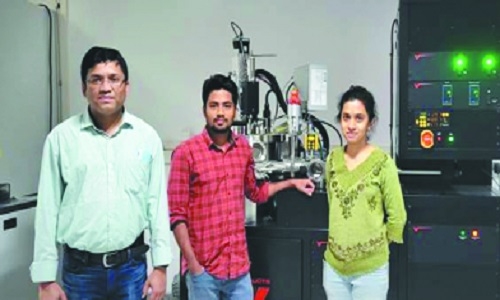Material that can convert infrared light to renewable energy discovered
| Date :06-Jul-2022 |

Delhi Bureau
NEW DELHI,
IN SIGNIFICANT development, researchers from Bengaluru’s Jawaharlal Nehru Centre for Advanced Scientific Research (JNCASR) have discovered Single-crystalline scandium nitride (ScN), a novel material that can convert infrared light to renewable energy. This material is useful in harvesting solar and thermal energy and help improve optical communication devices. According to an official release issued by the Union Ministry of Science and Technology in New Delhi on Tuesday, Scientist K C Maurya and his team at JNCASR an autonomous institute under the Department of Science & Technology (DST), have utilised a scientific phenomenon called polariton excitations that occur in tailored materials when light couples with either the collective free electron oscillations or polar lattice vibrations to achieve this feat.
The researchers have carefully controlled material properties to excite polaritons (a quasi-particle) and achieve strong light-matter interactions in single-crystalline scandium nitride (ScN) using infrared light, which can
emit, detect, and modulate infrared light with high efficiencies, making it useful for solar and thermal energy harvesting and for optical communication devices.
Apart from ScN, other materials belonging to same family of materials like gallium nitride (GaN), scandium nitride are compatible with modern complementary-metal-oxide-semiconductor (CMOS) or Si-chip technology and, therefore, could be easily integrated for on-chip optical communication devices.
Assistant Professor at JNCASR Dr. Bivas Saha said that from electronics-to-healthcare, defence and security-to-energy technologies, there is a great demand for infrared sources, emitters and sensors. Our work on infrared polaritons in scandium nitride will enable its applications in many such devices, he added. Apart from JNCASR, researchers from the Centre for Nano Science and Engineering from the Indian Institute of Science (IISc.) and the University of Sydney also participated in this study published recently in the scientific journal Nano Letters.
Electromagnetic waves are a renewable energy source used for electricity generation, telecommunication, defence and security technologies, sensors, and healthcare services. Scientists use high-tech methods to manipulate such waves precisely -- in dimensions that are thousands of times smaller than the human hair, using specialised materials. However, not all the wavelengths of light (electromagnetic waves) are easy to utilise, especially infrared light, since it is difficult to detect and modulate. For infrared light applications, intelligent and cutting-edge materials are required which can enable excitation, modulation, and detection at desired spectral range with high efficiencies. Only a few existing materials can serve as hosts for light-matter interactions in the infrared spectral range, albeit with very low efficiencies. The operational spectral range of such materials also does not cover the industrially important short wavelength infrared (SWIR) spectral range.